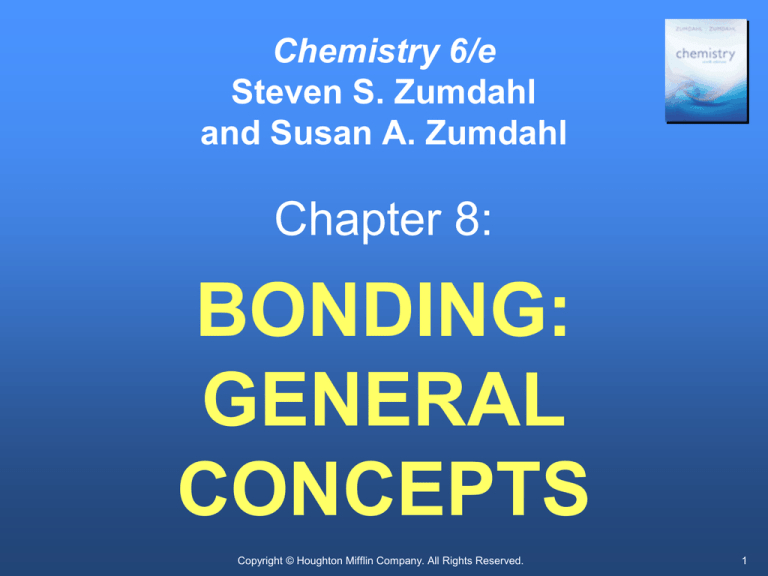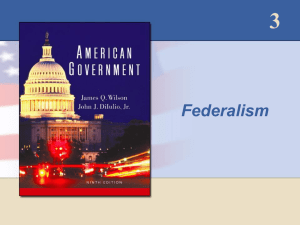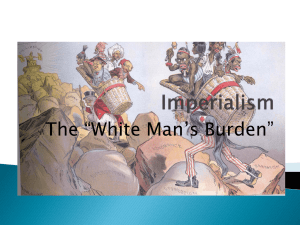
Chemistry 6/e
Steven S. Zumdahl
and Susan A. Zumdahl
Chapter 8:
BONDING:
GENERAL
CONCEPTS
Copyright © Houghton Mifflin Company. All Rights Reserved.
1
Bonding: General Concepts
• Types of Chemical
Bonds
• React 1
• Electronegativity
• React 2 • 3
• Bond Polarity and
Dipole Moments
• React 4 • 5 • 6
• Ions: Electron
Configurations and
Sizes
• React 7
• Formation of Binary
Ionic Compounds
• React 8 • 9 • 10 • 11
• React 12 • 13 • 14
Copyright © Houghton Mifflin Company. All Rights Reserved.
2
Questions to Consider
What is meant by the term “chemical
bond?”
Why do atoms bond with each other to
form molecules?
How do atoms bond with each other to
form molecules?
Copyright © Houghton Mifflin Company. All Rights Reserved.
3
Types of Chemical Bonds
Copyright © Houghton Mifflin Company. All Rights Reserved.
4
The Interaction of
Two Hydrogen
Atoms
Copyright © Houghton Mifflin Company. All Rights Reserved.
5
Energy profile as a function of the distance
between the nuclei of the hydrogen atoms
As the atoms approach each other (right side of graph),
the energy decreases until the distance reaches 0.074
nm (0.74 Å) and then begins to increase again due to
repulsions.
Copyright © Houghton Mifflin Company. All Rights Reserved.
6
Key Ideas in Bonding
Ionic Bonding: Electrons are transferred
Covalent Bonding: Electrons are shared
equally
What about intermediate cases?
Copyright © Houghton Mifflin Company. All Rights Reserved.
7
The Effect of an Electric Field on Hydrogen
Fluoride Molecules
Copyright © Houghton Mifflin Company. All Rights Reserved.
8
What is meant by the term “chemical
bond”?
Why do atoms bond with each other to
form molecules?
How do atoms bond with each other to
form molecules?
Copyright © Houghton Mifflin Company. All Rights Reserved.
9
Electronegativity
Copyright © Houghton Mifflin Company. All Rights Reserved.
10
If lithium and fluorine react, which has
more attraction for an electron? Why?
In a bond between fluorine and iodine,
which has more attraction for an electron?
Why?
Copyright © Houghton Mifflin Company. All Rights Reserved.
11
What is the general trend for
electronegativity across rows and down
columns on the periodic table?
Understand this trend, do not merely
memorize it.
Copyright © Houghton Mifflin Company. All Rights Reserved.
12
The Pauling Elecronegativity Values
Electronegativity generally increases across a
period and decreases down a group.
Copyright © Houghton Mifflin Company. All Rights Reserved.
13
The Relationship Between
Electronegativity and Bond Type
Electronegativity
Difference in the
Bonding Atoms
Zero
Covalent
Intermediate
Polar Covalent
Large
Ionic
Copyright © Houghton Mifflin Company. All Rights Reserved.
Covalent character
decreases; ionic
character increases
Bond
Type
14
Bond Polarity and
Dipole Moments
Copyright © Houghton Mifflin Company. All Rights Reserved.
15
Arrange the following bonds from most to
least polar:
I.
II.
III.
N-F
C-F
H-Cl
O-F
N-O
B-Cl
C-F
Si-F
S-Cl
Copyright © Houghton Mifflin Company. All Rights Reserved.
16
Which of the following bonds would be the
least polar yet still be considered polar
covalent?
Mg-O C-O
O-O
Si-O
N-O
Copyright © Houghton Mifflin Company. All Rights Reserved.
17
Which of the following bonds would be the
most polar without being considered
ionic?
Mg-O C-O
O-O
Si-O
N-O
Copyright © Houghton Mifflin Company. All Rights Reserved.
18
Ions: Electron Configurations
and Sizes
Copyright © Houghton Mifflin Company. All Rights Reserved.
19
Choose an alkali metal, an alkaline metal, a noble gas,
and a halogen so that they constitute an isoelectronic
series when the metals and halogen are written as their
most stable ions.
• What is the electron configuration for each species?
• Determine the number of electrons for each species.
• Determine the number of protons for each species.
• Rank the species according to increasing radius.
• Rank the species according to increasing ionization
energy.
Copyright © Houghton Mifflin Company. All Rights Reserved.
20
Sizes of Ions
Related to Positions
of the Elements in
the Periodic Table
Note that size generally
increases down a group.
Also note that in a series
of isoelectronic ions, size
decreases with
increasing atomic
number. The ionic radii
are given in units of
picometers.
Copyright © Houghton Mifflin Company. All Rights Reserved.
21
What we can “read” from the
periodic table:
Trends for
– Atomic size
– Ion radius
– Ionization energy
– Electronegativity
Electron configurations
Predicting formulas for ionic compounds
Ranking polarity of covalent bonds
Copyright © Houghton Mifflin Company. All Rights Reserved.
22
Formation of Binary Ionic
Compounds
Copyright © Houghton Mifflin Company. All Rights Reserved.
23
Comparison of
the energy
changes
involved in the
formation of
solid sodium
fluoride and
solid
magnesium
oxide.
Copyright © Houghton Mifflin Company. All Rights Reserved.
24
The relationship between the ionic character
of a covalent bond and the electronegativity
difference of the bonded atoms
Copyright © Houghton Mifflin Company. All Rights Reserved.
25
For a given molecule we want to:
• Describe the valence electron
arrangement in the molecule (Lewis
structure)
• Predict the geometry (VSEPR)
• Specify the atomic orbitals involved in
the molecule
Copyright © Houghton Mifflin Company. All Rights Reserved.
26
Lewis Structures
1. Sum the valence electrons.
2. Place bonding electrons between pairs
of atoms.
3. Atoms usually have noble gas
configurations.
Copyright © Houghton Mifflin Company. All Rights Reserved.
27
Draw a Lewis structure for each of the
following molecules:
H2
N2
O2
Copyright © Houghton Mifflin Company. All Rights Reserved.
F2
28
Draw a Lewis structure for each of the
following molecules:
H 2O
NH3
Copyright © Houghton Mifflin Company. All Rights Reserved.
29
Draw a Lewis structure for each of the
following molecules:
CO
CO2
H3COH
BF3
C 2H 6O
PCl5
NO3SF6
Copyright © Houghton Mifflin Company. All Rights Reserved.
30
VSEPR
To approximate molecular geometries:
1. Write Lewis structure.
2. Count electron pairs.
3. Choose an arrangement that
minimizes electron-pair repulsions.
Copyright © Houghton Mifflin Company. All Rights Reserved.
31
Determine the shape of each of the
following molecules including bond
angles:
HCN
PH3
SF4
O3
Copyright © Houghton Mifflin Company. All Rights Reserved.
KrF4
32
If you are asked to determine the shape
of a molecule, what is always the first
step?
How do we deal with multiple bonds with
VSEPR theory?
If more than one atom can break the octet
rule in a molecule, what do we do?
Copyright © Houghton Mifflin Company. All Rights Reserved.
33
True or false:
A molecule that has polar bonds will
always be polar.
If true, explain why.
If false, provide a counterexample.
Copyright © Houghton Mifflin Company. All Rights Reserved.
34
True or false:
Lone pairs make a molecule polar.
If true, explain why.
If false, provide a counterexample.
Copyright © Houghton Mifflin Company. All Rights Reserved.
35







